This information has been commissioned by the Goulburn Murray Valley (GMV) Fruit Fly Program and is funded by the Victorian Government. Use of this material in its complete and original format, acknowledging its source, is permitted, however unauthorised alterations to the text or content is not permitted.
Current trends in Queensland fruit fly populations and the outlook for March 2022
- Numbers of Queensland fruit fly trapped in the Goulburn Murray Valley jumped significantly during the first 2 weeks of February.
- The jump in Queensland fruit fly numbers occurred mainly in urban areas of.
- Currently, weather conditions are suitable for fruit fly to mate and lay eggs
- Eggs laid during January and February will become a new generation of pest fruit flies in late summer and autumn which will attack autumn crops of fruit and fruiting vegetables. Ripe or ripening fruit under irrigation are particularly susceptible to fruit fly stinging fruit at this time.
- These flies will spread from urban areas, through peri-urban sites and into commercial crops from late February.
- Action now will cut the next fruit fly generation and increase future home garden productivity –
- Fruit and tree removal and destruction, fruit fly baits, netting, monitoring ripening fruit for sting marks or with traps in home gardens, untended areas, council and Crown land, roadsides, riverbanks, business sites, etc.
- Action for commercial orchardists include:
- Ensure fresh (or within use-by date) traps are deployed and are being checked as often as possible – certainly once a week.
- Check ripe and ripening fruit for fruit fly sting marks – preferably daily.
- If fruit fly is a constant problem, ensure supplies of control material such as baits and approved pesticides are in storage and within their use-by dates.
General trend
Trapping data for Cobram (rural and urban) are not included in this report because sterile Queensland fruit fly have not been separated from wild fruit fly since late January due to the Sterile Insect Technique Pilot Trial being carried out in Cobram. When these data are known they will be reported.
During January and the first 2 weeks of February 2022, a total of 2,903 fruit fly were trapped from about 295 traps (Figure 1). This is lower than for the same period last year which recorded 3,365 Queensland fruit fly.
This year the general trend in numbers is following the usual pattern. Queensland fruit fly numbers being trapped are now on the rise in peri-urban and rural areas but declining in urban areas – although urban fruit fly numbers per trap are still dominating the Goulburn Murray Valley landscape.
Last year’s fruit fly season was a heavy year for Queensland fruit fly. This was most likely due to a combination of benign weather conditions during the previous autumn, winter and spring (i.e. La Nińa event); plus a large volume of unharvested host crop due to COVID restrictions. It is believed that the combination of the Goulburn Murray Valley’s area-wide management program and periodic weather conditions impacted adversely on fruit fly survival this season.
The graph below (Figure 1) shows that there has been a decline in numbers of Queensland fruit fly trapped during the late spring and early summer this year compared with last year. However, fruit fly numbers have jumped significantly during the last 2 weeks (Fig. 1).
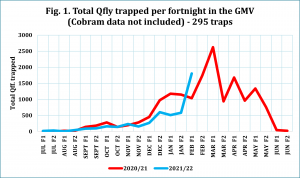
Impact of land use type
During the three-week period to 18 February 2022 rural traps caught 585 fruit fly (3.5 fruit fly/trap) while the majority (970, at 12.3 fruit fly/trap) were trapped in urban locations. Peri-urban traps caught 329 (6.6 fruit fly/trap) (Table 1).
Urban Queensland fruit fly populations dominate the Goulburn Murray Valley at present (Table 1) although they tended to decline during the third week of this period (Figs 2 and 5). Peri-urban fruit fly are building up (Figs 3 and 5). Rural populations were static for the first 2 weeks but are now on the rise (Figs 4 and5).
Table 1. Total Queensland fruit fly trapped over the past 3 weeks according to land use (Cobram data excluded) [295 traps].

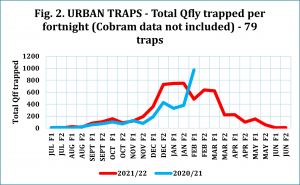
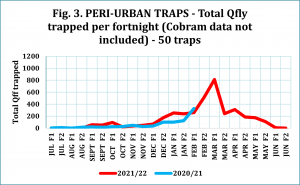
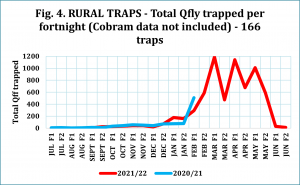
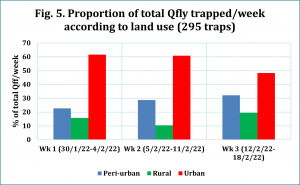
Outlook for home gardeners in the Goulburn Murray Valley
Typically, at this time of year fruiting plants are finishing off in urban areas of the Goulburn Murray Valley as fruit is harvested, eaten by birds or deteriorate and fall off due to hot, dry weather. As a result, fruit fly populations generally decline during January and February in urban areas of the region. With current relatively benign weather conditions fruit and, consequently, fruit flies are staying on the landscape longer than usual in urban areas. In the case of Queensland fruit fly, they are living longer and, hence, laying more eggs – and, staying for longer periods in urban areas. This significant urban inoculum of fruit fly will probably spread to commercial orchards in late summer and autumn in response to large volumes of ripening and ripe fruit.
The Bureau of Meteorology forecasts benign weather conditions for fruit fly survival and spread (see section below on Weather Outlook). These weather patterns favour the survival of both fruit on tree/vine/bush and fruit fly.
It is worth noting that irrigation provides ideal conditions for fruit fly maturation, survival and proliferation in urban, peri-urban and rural areas. Populations can explode and then, when crops in urban locations are diminished, will move out of urban areas, into and through peri-urban places and into commercial orchards. This migration is facilitated by high volumes of fruit in commercial orchards ripening from February through May and, in some cases, irrigation. If urban growers can deal with fruit fly in their gardens using the usual area-wide management strategies described in the key points above, they will achieve good production in their own garden and also assist commercial growers by cutting off the urban-to-rural migration of fruit fly.
Outlook for commercial horticultural production
Queensland fruit fly start to build up in peri-urban and rural locations of the Goulburn Murray Valley during February. Many fruit fly move out of urban areas and into rural locations due to lack of resources, irrigation in rural areas and mass-ripening of fresh fruit. However, some fruit fly may have overwintered in rural locations within evergreen canopies often in sites close to houses and other heated out-buildings. These flies will start moving out of hibernation and start looking for mates and fresh ripening fruit to infest.
It is essential for commercial growers to ensure there are no unwanted fruiting plants within about 1km of their orchard: roadside feral fruits (e.g. peaches), plants along creek banks, on Crown land, abandoned orchards and, very importantly, the house yards of your orchard and the neighbours. These fruit are the staging points for a rapid increase in fruit fly populations that would then threaten crops.
Commercial orchards situated within 1km of hot spot locations mentioned below are especially at risk from Queensland fruit fly. Vigilance with traps and by fruit checking is essential here.
Regional hot spots
Up to the first week of February 2022 there was a general trend of a lower fruit fly count this season compared with last season. This then changed with a marked jump in numbers throughout urban, peri-urban and rural locations. Urban populations are still dominating the Goulburn Murray Valley.
There are a few locations that bias total numbers heavily. These are the so-called ‘hot spots’. Hot spots can be habitual, where they occur each year at approximately the same time or they can be new hot spots where fruit fly have moved into a new area, settle there and proliferate.
Active area-wide management works, especially netting and host plant removal (in urban areas), baiting (in commercial production areas), trap monitoring and fruit checking (in all areas of the Goulburn Murray Valley) will, over time, erase these hot spots. There have been some successes in hot spot deletion in the region since the project commenced.
At present 63% of Goulburn Murray Valley’s Queensland fruit fly hot spots are located in urban areas (Table 2).
Table 2. Presence of fruit fly hot spots (sites trapping ³ 12 fruit fly in the last 3 weeks) according to land use type.

Table 3. Locations with trapping sites registering 12 or more Queensland fruit fly in total over the last 3 weeks.

The abovementioned sites are of concern as they could become sites from which large numbers of fruit fly could establish and then spread, so it is important that members of the community who have gardens and orchards in these areas take precautions to reduce the ability of fruit fly to infest fruit and to survive in them.
Weather outlook and its impact on fruit fly
Over the next few weeks, the numbers of Queensland fruit fly trapped in the Goulburn Murray Valley, if they follow normal trends, will rise. This will be the commencement of the peak fruit fly season for 2021/22 which will then spread, if left untouched, from urban areas to commercial orchards in the local district.
Weather forecasts for March 2022 were accessed from the Bureau of Meteorology data indicates that:
- There is a 55% to 60% chance that rainfall over the region will exceed the average (which is predominantly 10-25mm for March based on the past 10 years).
- Impact on fruit fly survival and spread: – FAVOURABLE
- There is only a 40% to 50% chance that maximum temperatures will be higher than the average of 27-30°C. Bureau of Meteorology forecasts an average cooling of maximum temperatures for February by 0°C to 1°C.
- Impact on fruit fly survival and spread: – FAVOURABLE
- There is a 60% to 70% chance that minimum temperatures will be above average of 12°C to 15°C. Average minimum temperatures will be 0°C to 1°C warmer than average.
- Impact on fruit fly survival and spread: – FAVOURABLE
The Bureau of Meteorology’s forecasts suggest that March conditions will not differ appreciably from the average. Although the forecast temperatures are optimal for fruit fly survival and development rainfall is a limiting factor. Fruit fly survival in areas of low summer rainfall is enhanced by the prevalence of urban irrigation and the presence of evergreen canopies in which fruit fly can find shelter. Orchards outside of urban areas are now starting to produce large volumes of ripening and ripe fruit, often with irrigation. During late February and March fruit fly will migrate from urban areas, through peri-urban orchards and gardens and into outlying rural commercial orchards and gardens.
Figure 6. Chance of exceeding median rainfall in March 2022
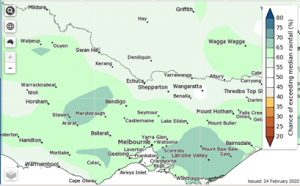
Figure 7. Maximum temperatures: likely differences from the average for weeks 1 and 2 of March 2022
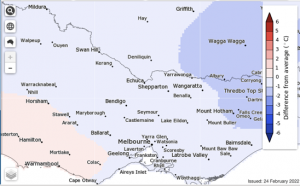
Figure 8. Maximum temperatures: likely differences from the average for weeks 3 and 4 of March 2022
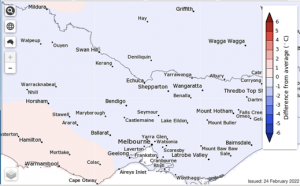
Figure 9: Minimum temperatures: likely differences from the average for weeks 1 and 2 of March 2022

Figure 10: Minimum temperatures: likely differences from the average for weeks 3 and 4 of March 2022
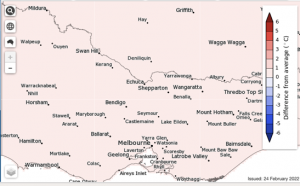
Goulburn Murray Valley Fruit Fly Program
For assistance in managing fruit fly, contact the Project Coordinator at the Goulburn Murray Valley Fruit Fly Office by phoning (03) 5871 9222 or email gmvfruitfly@moira.vic.gov.au. For more information on fruit fly control and area wide management strategies visit www.fruitflycontrol.com.au
This report was produced and supplied by Janren Consulting Pty Ltd for the purpose of the Goulburn Murray Valley Fruit Fly Program. The program is supported by the Victorian Government.
